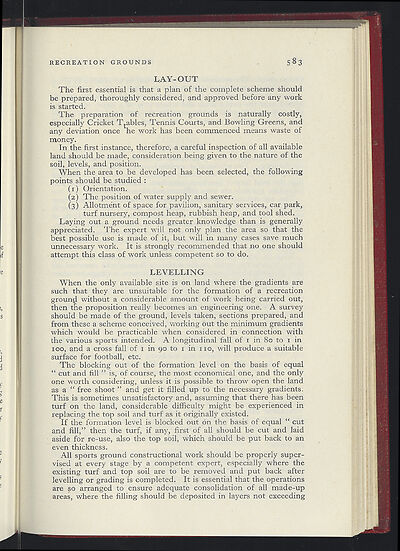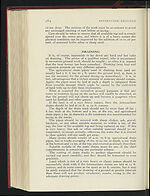1938-39
(617)
Download files
Complete book:
Individual page:
Thumbnail gallery: Grid view | List view

RECREATION GROUNDS
583
e
f
s
s
LAY-OUT
The first essential is that a plan of the complete scheme should
be prepared, thoroughly considered, and approved before any work
is started.
The preparation of recreation grounds is naturally costly,
especially Cricket T
t
ables, Tennis Courts, and Bowling Greens, and
any deviation once he work has been commenced means waste of
money.
In the first instance, therefore, a careful inspection of all available
land should be made, consideration being given to the nature of the
soil, levels, and position.
When the area to be developed has been selected, the following
points should be studied
(I)
Orientation.
(2)
The position of water supply and. sewer.
(3) Allotment of space for pavilion, sanitary services, car park,
turf nursery, compost heap, rubbish heap, and tool shed.
Laying out a ground needs greater knowledge than is generally
appreciated. The expert will not only plan the area so that the
best possible use is made of it, but will in many cases save much
unnecessary work. It is strongly recommended that no one should
attempt this class of work unless competent so to do.
LEVELLING
When the only available site is on land where the gradients are
such that they are unsuitable for the formation of a recreation
groun without a considerable amount of work being carried out,
then t e proposition really becomes an engineering one. A survey
should be made of the ground, levels taken, sections prepared, and
from these a scheme conceived, working out the minimum gradients
which would be practicable when considered in connection with
the various sports intended. A longitudinal fall of i in 8o to i in
r oo, and a cross fall of i in 90 to i in i i o, will produce a suitable
surface for football, etc.
The blocking out of the formation level on the basis of equal
" cut and fill " is, of course, the most economical one, and the only
one worth considering, unless it is possible to throw open the land
as a " free shoot " and get it filled up to the necessary gradients.
This is sometimes unsatisfactory and, assuming that there has been
turf on the land, considerable difficulty might be experienced in
replacing the top soil and turf as it originally existed.
If the formation level is blocked out on the basis of equal " cut
and fill," then the turf, if any, first of all should be cut and laid
aside for re-use, also the top soil, which should be put back to an
even thickness.
All sports ground constructional work should be properly super-
vised at every stage by a competent expert, especially where the
existing turf and top soil are to be removed and put back after
levelling or grading is completed. It is essential that the operations
are so arranged to ensure adequate consolidation of
all
made-up
areas, where the filling should be deposited in layers not exceeding
583
e
f
s
s
LAY-OUT
The first essential is that a plan of the complete scheme should
be prepared, thoroughly considered, and approved before any work
is started.
The preparation of recreation grounds is naturally costly,
especially Cricket T
t
ables, Tennis Courts, and Bowling Greens, and
any deviation once he work has been commenced means waste of
money.
In the first instance, therefore, a careful inspection of all available
land should be made, consideration being given to the nature of the
soil, levels, and position.
When the area to be developed has been selected, the following
points should be studied
(I)
Orientation.
(2)
The position of water supply and. sewer.
(3) Allotment of space for pavilion, sanitary services, car park,
turf nursery, compost heap, rubbish heap, and tool shed.
Laying out a ground needs greater knowledge than is generally
appreciated. The expert will not only plan the area so that the
best possible use is made of it, but will in many cases save much
unnecessary work. It is strongly recommended that no one should
attempt this class of work unless competent so to do.
LEVELLING
When the only available site is on land where the gradients are
such that they are unsuitable for the formation of a recreation
groun without a considerable amount of work being carried out,
then t e proposition really becomes an engineering one. A survey
should be made of the ground, levels taken, sections prepared, and
from these a scheme conceived, working out the minimum gradients
which would be practicable when considered in connection with
the various sports intended. A longitudinal fall of i in 8o to i in
r oo, and a cross fall of i in 90 to i in i i o, will produce a suitable
surface for football, etc.
The blocking out of the formation level on the basis of equal
" cut and fill " is, of course, the most economical one, and the only
one worth considering, unless it is possible to throw open the land
as a " free shoot " and get it filled up to the necessary gradients.
This is sometimes unsatisfactory and, assuming that there has been
turf on the land, considerable difficulty might be experienced in
replacing the top soil and turf as it originally existed.
If the formation level is blocked out on the basis of equal " cut
and fill," then the turf, if any, first of all should be cut and laid
aside for re-use, also the top soil, which should be put back to an
even thickness.
All sports ground constructional work should be properly super-
vised at every stage by a competent expert, especially where the
existing turf and top soil are to be removed and put back after
levelling or grading is completed. It is essential that the operations
are so arranged to ensure adequate consolidation of
all
made-up
areas, where the filling should be deposited in layers not exceeding
Set display mode to:
![]() Universal Viewer |
Universal Viewer | ![]() Mirador |
Large image | Transcription
Mirador |
Large image | Transcription
| Games and sports in the army > 1938-39 > (617) |
|---|
| Permanent URL | https://digital.nls.uk/248744627 |
|---|
| Description | 'Games and Sports in the Army' was an annual publication produced by the British War Office between the 1930s and 1960s. This included the Second World War. It outlines the rules and regulations for games and sports played by members of the armed forces. It features names and photographs of team members, and examples of contemporary advertising. |
|---|---|
| Shelfmark | GWB.52 |

